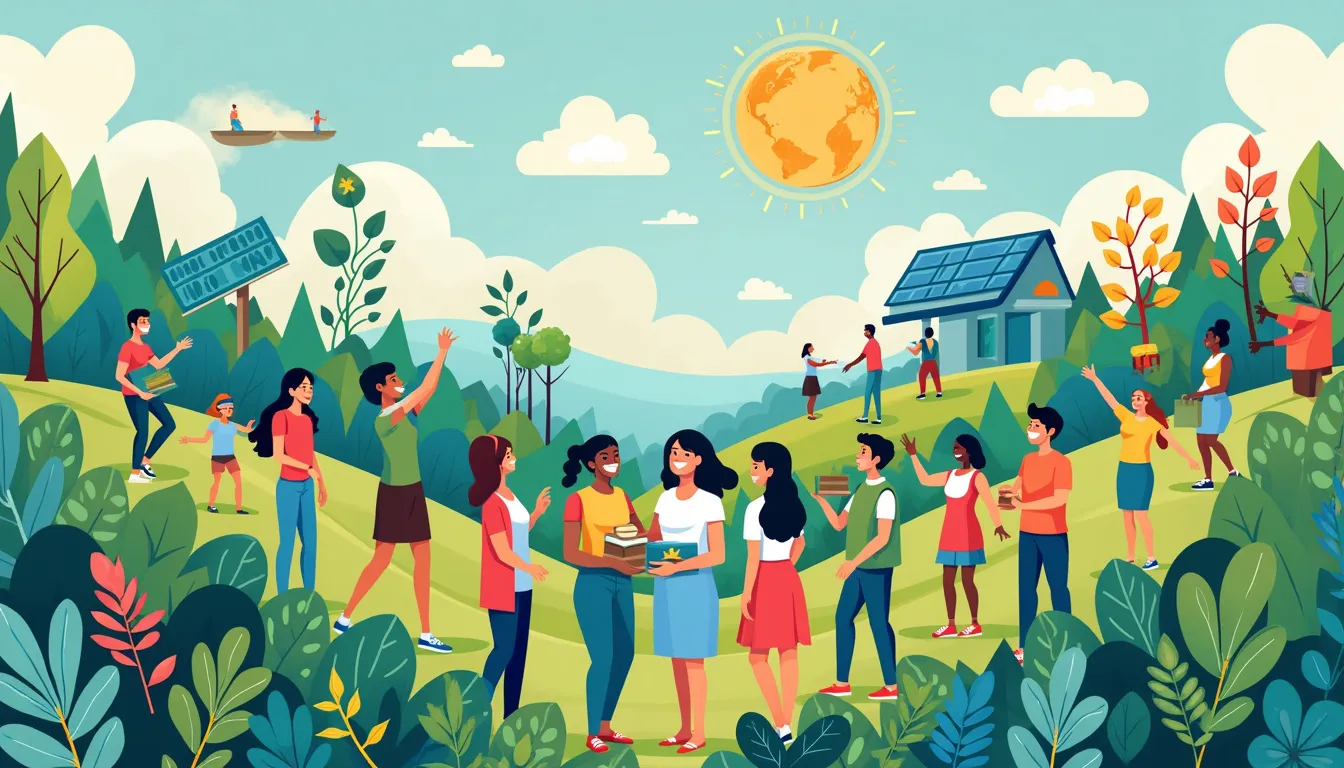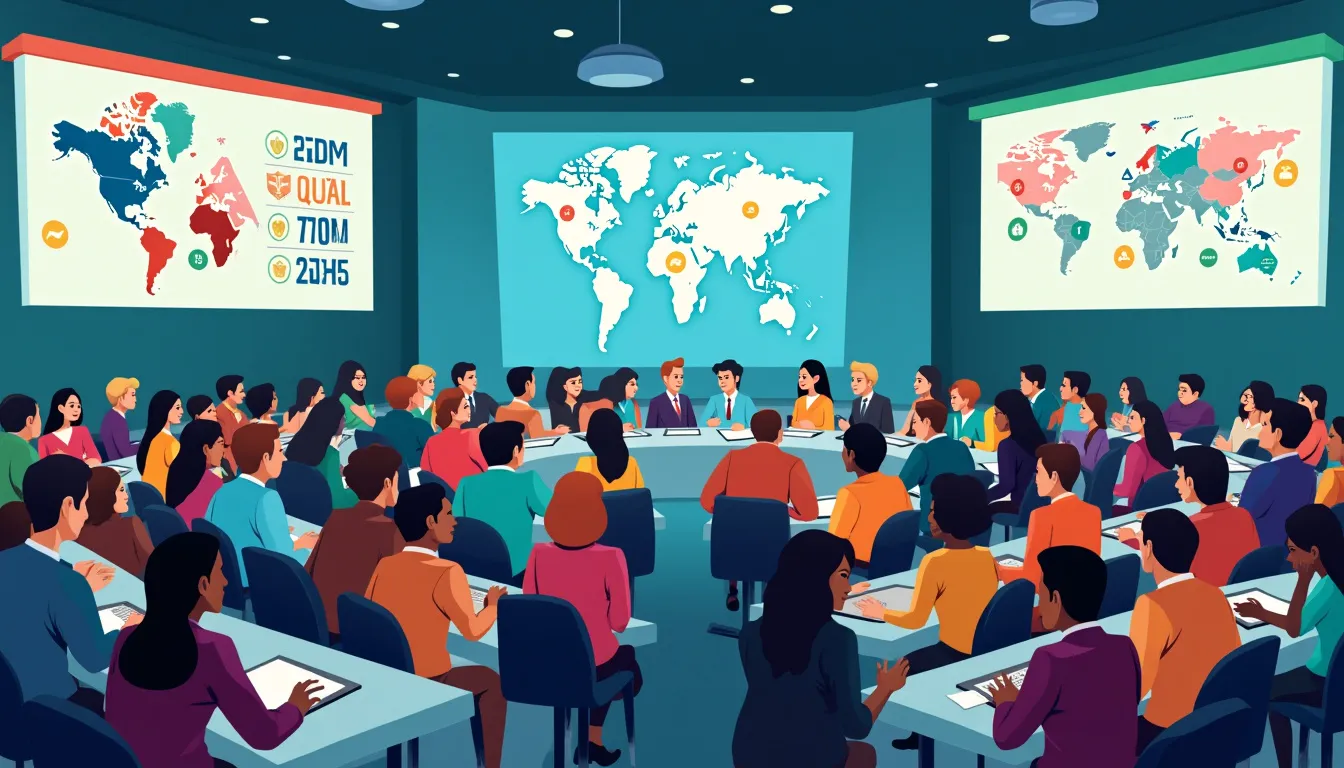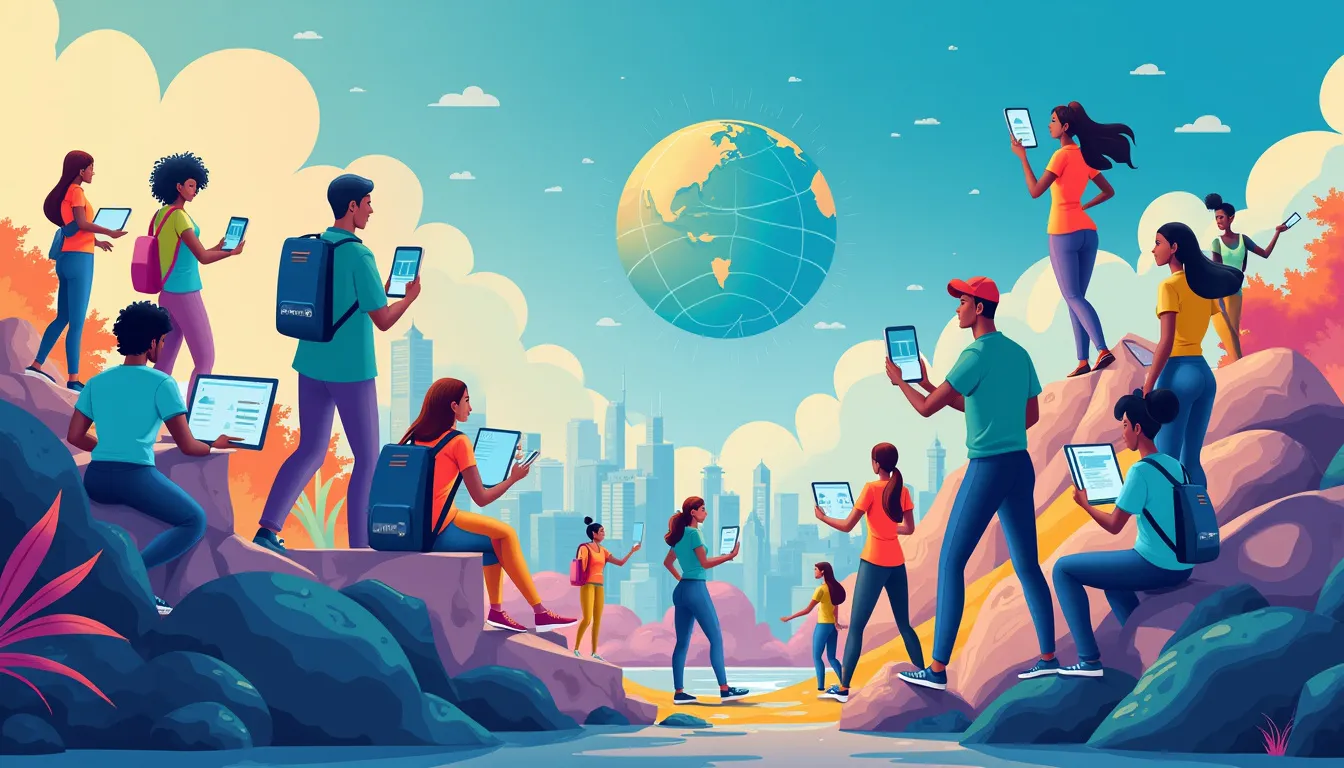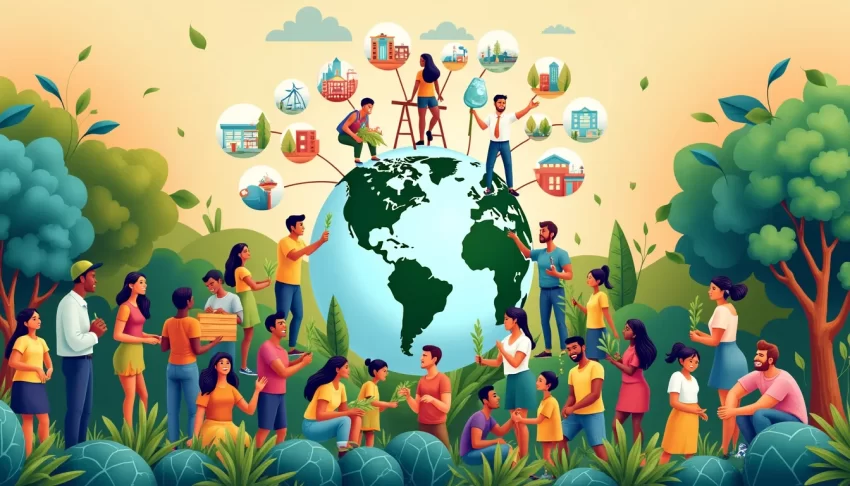In an increasingly interconnected world, the need for unified efforts toward sustainability has never been more critical. This is where the United Nations Sustainable Development Goals (UN SDGs) come into play. Established in 2015, the UN SDGs present a blueprint for peace and prosperity for people and the planet, now and into the future. These 17 goals were adopted by all United Nations Member States as part of the 2030 Agenda for Sustainable Development, a global call to action to end poverty, protect the planet, and ensure that all people enjoy peace and prosperity by 2030.
The UN Sustainable Development Goals are not just lofty ideals but practical objectives that resonate with our daily lives and the future of our businesses. They cover a wide range of pressing issues, from eradicating hunger and ensuring quality education for all, to taking urgent action to combat climate change. In today’s global context, the importance of these goals cannot be overstated. They provide a comprehensive framework that guides nations, corporations, and individuals alike towards a common purpose.
Understanding and achieving these goals requires an appreciation of their interconnected nature. For example, improving educational opportunities can lead to better economic prospects, which in turn can reduce poverty and hunger. As we delve deeper into each goal, it becomes clear how they support and amplify one another, creating a holistic approach to global development.
In the sections that follow, we will explore the key areas of focus within the UN Sustainable Development Goals, examining specific objectives like zero hunger, quality education, and climate action, and discuss the collaborative global efforts and initiatives driving progress. We will highlight inspiring examples of countries and organizations making significant strides, the pivotal role played by governments, NGOs, and the private sector, and the innovative technologies bolstering these efforts. Despite the challenges we face, there are actionable strategies and collaborations that can fast-track our journey towards these critical targets.
Whether you’re a business owner looking to align your operations with sustainable practices or an individual keen to make a positive impact, understanding and contributing to the UN Sustainable Development Goals is both a responsibility and an opportunity to be part of a global movement towards a more sustainable future.
Introduction to the UN Sustainable Development Goals
Brief Overview of the UN Sustainable Development Goals (SDGs)
The United Nations Sustainable Development Goals (SDGs) consist of a set of 17 interconnected global goals designed to achieve a better and more sustainable future for all. Adopted by all United Nations Member States in 2015, the SDGs address a wide range of global challenges, including poverty, inequality, climate change, environmental degradation, peace, and justice. Each goal has specific targets and indicators to measure progress, providing a robust framework to tackle the most urgent challenges of the 21st century.
Importance and Relevance of the SDGs in Today’s Global Context
In an increasingly globalized world, the relevance of the UN Sustainable Development Goals cannot be overstated. The COVID-19 pandemic, for example, has shown how interconnected our world is and the importance of global solidarity in tackling shared challenges. The SDGs provide a blueprint for building resilient societies, promoting inclusive economic growth, ensuring social equity, and safeguarding our planet’s natural resources. These goals help to align international policies and initiatives, foster collaborations across borders, and mobilize resources efficiently to address critical global issues.
Moreover, the SDGs are crucial for economic stability. According to the United Nations, addressing issues such as hunger, healthcare, and education not only improves quality of life but also stimulates economic growth by creating stable and productive workforces. Sustainable practices, from energy to agriculture, help mitigate risks posed by climate change and resource depletion, ensuring long-term economic resilience.
Individual engagement with the SDGs also plays a significant role. By understanding and supporting these goals, people worldwide can contribute to building a sustainable future. The SDGs encourage individuals to adopt sustainable lifestyles, advocate for policies that support sustainable development, and participate in community initiatives to drive meaningful change.
For businesses, the SDGs provide an opportunity to align their operations with global priorities, improving their sustainability credentials and competitiveness. Companies adopting sustainable practices often see benefits such as cost savings, enhanced brand reputation, and increased customer loyalty. Additionally, the SDGs open new markets and innovation opportunities. A report by the Business & Sustainable Development Commission suggests that achieving the SDGs could create market opportunities worth up to $12 trillion by 2030.
In summary, the UN Sustainable Development Goals are an essential roadmap for both present and future generations. They provide a unified framework for addressing the most pressing challenges of our time, promoting a more inclusive, equitable, and sustainable world for all.

Key Areas of Focus within the UN Sustainable Development Goals
The UN Sustainable Development Goals (SDGs) encompass 17 interconnected goals designed to achieve a better and more sustainable future for all. These goals address global challenges, including poverty, inequality, climate change, environmental degradation, peace, and justice. Understanding the breadth and depth of these goals is crucial for both individuals and businesses seeking to contribute to global sustainability efforts.
Breaking Down the 17 Goals
Each of the 17 SDGs has specific targets and indicators that help measure progress. Here’s a brief look at some of these goals:
- No Poverty: End poverty in all its forms everywhere.
- Zero Hunger: End hunger, achieve food security and improved nutrition, and promote sustainable agriculture.
- Good Health and Well-being: Ensure healthy lives and promote well-being for all at all ages.
- Quality Education: Ensure inclusive and equitable quality education and promote lifelong learning opportunities for all.
- Gender Equality: Achieve gender equality and empower all women and girls.
- Clean Water and Sanitation: Ensure availability and sustainable management of water and sanitation for all.
- Affordable and Clean Energy: Ensure access to affordable, reliable, sustainable, and modern energy for all.
- Decent Work and Economic Growth: Promote sustained, inclusive, and sustainable economic growth, full and productive employment, and decent work for all.
- Industry, Innovation, and Infrastructure: Build resilient infrastructure, promote inclusive and sustainable industrialization, and foster innovation.
- Reduced Inequality: Reduce inequality within and among countries.
- Sustainable Cities and Communities: Make cities and human settlements inclusive, safe, resilient, and sustainable.
- Responsible Consumption and Production: Ensure sustainable consumption and production patterns.
- Climate Action: Take urgent action to combat climate change and its impacts.
- Life Below Water: Conserve and sustainably use the oceans, seas, and marine resources for sustainable development.
- Life on Land: Protect, restore, and promote sustainable use of terrestrial ecosystems, manage forests sustainably, combat desertification, and halt and reverse land degradation and halt biodiversity loss.
- Peace, Justice, and Strong Institutions: Promote peaceful and inclusive societies for sustainable development, provide access to justice for all, and build effective, accountable, and inclusive institutions at all levels.
- Partnerships for the Goals: Strengthen the means of implementation and revitalize the global partnership for sustainable development.
Highlighting Significant Goals
While every one of the 17 goals is essential, a few stand out due to their broad impact and the urgency of their respective issues:
Zero Hunger
Goal 2, Zero Hunger, aims to end hunger, achieve food security, enhance nutrition, and promote sustainable agriculture. This goal is critical, as nearly 690 million people worldwide are undernourished. Innovative solutions such as precision farming, genetic crop development, and vertical farming can significantly improve food security and sustainability. For instance, countries like the Netherlands have shown how cutting-edge farming techniques can lead to high yields with minimal environmental impact.
Quality Education
Goal 4, Quality Education, emphasizes inclusive and equitable education for all. Access to quality education is a fundamental human right and a cornerstone for achieving other SDGs. Programs like UNESCO’s Global Education Monitoring Report highlight the importance of good governance in education and the roles of teachers, students, and parents in fostering lifelong learning environments. Education initiatives, such as those led by NGOs like Room to Read, are paving the way toward significant improvements in literacy and gender equality in education.
Climate Action
Goal 13, Climate Action, addresses the need for urgent measures to combat climate change. From increasing global temperatures to more frequent and severe natural disasters, the impacts of climate change are profound and far-reaching. Efforts such as the Paris Agreement aim to mitigate these impacts by committing countries to significantly reduce greenhouse gas emissions. Additionally, businesses and innovators are contributing by developing renewable energy technologies and promoting sustainable practices. For example, Tesla’s advancements in electric vehicles and battery storage are driving significant progress in reducing carbon footprints.
The Interconnectivity of the Goals
One of the most compelling aspects of the UN Sustainable Development Goals is their interconnectivity. Progress in one area often drives improvements in others. For example, achieving zero hunger can lead to better health outcomes (Goal 3), which in turn can improve educational attainment (Goal 4). Sustainable agriculture practices (Goal 2) also contribute to climate action (Goal 13) by reducing greenhouse gas emissions and protecting biodiversity (Life on Land, Goal 15).
This interconnected approach is essential for systemic change. Take the example of rural electrification programs: by providing clean energy to isolated communities (Goal 7), we can improve health care facilities (Goal 3), enhance educational opportunities through better lighting and access to information (Goal 4), and foster economic growth by enabling businesses to operate more effectively (Goal 8).
By recognizing and leveraging these connections, both individuals and businesses can make more impactful contributions toward achieving the SDGs. Incorporating sustainable practices in daily lives and business operations not only helps attain these goals but also contributes to building a more resilient and equitable global society.

Global Efforts and Initiatives to Achieve the SDGs
Achieving the UN Sustainable Development Goals (SDGs) requires a concerted effort from multiple sectors worldwide. Governments, non-governmental organizations (NGOs), private companies, and international coalitions are actively involved in numerous initiatives to drive progress. Let’s explore some inspiring examples, the collaborative roles these entities play, and the innovative technologies being utilized to meet the SDGs head-on.
Successful Initiatives by Countries and International Organizations
Several nations have set exemplary standards in their pursuit of the UN Sustainable Development Goals. For instance, Denmark has consistently topped the SDG Index, thanks to its comprehensive strategies in renewable energy and social welfare. The country’s ambitious targets for reducing carbon emissions and investing in green technologies have set a benchmark for others to follow.
On a broader scale, international organizations such as the United Nations Development Programme (UNDP) have spearheaded projects in various sectors. The UNDP’s Green Climate Fund has mobilized billions of dollars to support climate resilience projects in vulnerable countries. Uganda, for example, benefitted from a climate-resilient agriculture project funded by the Green Climate Fund, empowering local farmers to adopt sustainable farming practices and boost their yields.
The Role of Governments, NGOs, and the Private Sector
Governments play a crucial role as policymakers and enablers. Many have integrated the SDGs into their national planning and budgetary frameworks, exemplifying their commitment. One notable effort is Germany’s National Sustainable Development Strategy, which aligns its economic and social policies with the SDGs, ensuring a systematic approach to sustainability.
NGOs are pivotal in bridging gaps, advocating for marginalized communities, and spearheading grassroots initiatives. Take WaterAid as an example: this international non-profit works tirelessly to ensure access to clean water and sanitation across developing countries. Their impact is monumental in achieving Goal 6: Clean Water and Sanitation.
The private sector’s involvement is equally essential and is increasingly seen as a driver of innovation and efficiency. Companies like Unilever and Patagonia lead by example through their commitment to sustainable practices and corporate social responsibility. Unilever’s Sustainable Living Plan aims to improve health and well-being, reduce environmental impact, and enhance livelihoods across their supply chain. By setting ambitious targets and transparently reporting progress, these companies inspire others to follow suit.
Innovative Technologies and Solutions
The advancement of technology is a powerful ally in the quest to achieve the UN Sustainable Development Goals. Innovations in renewable energy, digital technologies, and sustainable materials are reshaping how we approach these global challenges.
Renewable energy is at the forefront, driving significant progress toward Goal 7: Affordable and Clean Energy. Projects like the solar power revolution in India and the expansion of wind farms in the United States exemplify how technology can harness natural resources efficiently. India’s International Solar Alliance, which aims to promote solar energy in 121 countries, underscores the global nature of this effort and its transformative potential.
Digital technology is another game-changer. From advanced data analytics to the Internet of Things (IoT), digital tools enable better resource management and decision-making. For instance, precision agriculture uses IoT devices to monitor soil conditions, optimize water usage, and increase crop yields, directly contributing to Goal 2: Zero Hunger.
Materials science is also making strides in sustainability. Innovations in biodegradable plastics and sustainable construction materials are reducing the environmental footprint of industries. The adoption of circular economy principles, where products are designed for reuse and recycling, is particularly notable. For example, the fashion brand Stella McCartney integrates circular design principles to minimize waste and has partnered with innovators in biofabrication to create sustainable textiles.
In conclusion, the global efforts and initiatives to achieve the UN Sustainable Development Goals are marked by a collaboration that spans countries and sectors. The integration of government policies, NGO advocacy, private sector innovation, and cutting-edge technologies forms a cohesive approach to tackling the world’s most pressing challenges. With continued dedication and cross-sector partnerships, the vision of a sustainable future outlined in the SDGs becomes increasingly attainable.

Challenges and Future Directions
Despite the global efforts dedicated to achieving the UN Sustainable Development Goals (SDGs), several challenges hinder progress. Understanding these hurdles is crucial for formulating effective strategies and ensuring a sustainable future for all.
Major Obstacles in Achieving the UN Sustainable Development Goals
The journey toward achieving the SDGs is fraught with significant obstacles, many of which are deeply rooted in complex socio-economic and political intricacies.
- Poverty and Inequality: Despite efforts, substantial disparities in wealth and opportunities remain. More than 700 million people live in extreme poverty, struggling to meet basic needs like food, water, and shelter. This inequality extends to access to education, healthcare, and employment.
- Environmental Degradation: Climate change and environmental degradation pose severe risks to achieving the SDGs. Deforestation, loss of biodiversity, and pollution undermine efforts to ensure clean water, sustainable cities, and life on land and below water.
- Political Instability and Conflict: Regions plagued by conflict and political instability face significant setbacks. Wars and unrest disrupt economies, displace populations, and divert resources away from development initiatives.
- Ineffective Governance: Corruption, lack of transparency, and weak institutions hinder progress. Effective governance is essential to implement policies and allocate resources efficiently and equitably.
- Funding Gaps: Achieving the SDGs requires substantial financial investment. Many developing countries struggle to mobilize the necessary resources, and international aid often falls short. The COVID-19 pandemic has further strained budgets, redirecting funds towards immediate health and economic relief.
Potential Strategies to Overcome These Challenges
Tackling these obstacles requires innovative solutions and coordinated efforts across various sectors.
- Promoting Inclusive Economic Growth: Creating job opportunities and fostering inclusive growth can reduce poverty and inequality. Policies that support small and medium enterprises (SMEs), provide vocational training, and ensure fair wages are vital.
- Investing in Education and Healthcare: Education and health are critical drivers of sustainable development. Increasing investment in these areas can empower communities, reduce inequalities, and promote healthy lives. Emphasizing gender equality in these sectors is also essential to ensure no one is left behind.
- Leveraging Technology and Innovation: Modern technologies can bridge gaps in education, healthcare, and infrastructure. Remote learning, telemedicine, and renewable energy solutions are examples of how technology can drive progress toward the SDGs.
- Strengthening Institutions: Building robust, transparent, and accountable institutions is crucial. Good governance practices, anti-corruption measures, and inclusive policymaking can significantly enhance the implementation of SDG policies.
- Encouraging International Cooperation: Global challenges require global solutions. Enhanced international cooperation, including fair trade practices, knowledge sharing, and financial support, can help build a resilient global community.
The Importance of Collaboration and Sustained Effort for Future Progress
The SDGs are interconnected, and progress in one area can significantly impact others. Collaboration between governments, the private sector, civil society, and individuals is paramount to achieve sustained success.
One inspiring example of successful collaboration is the Global Partnership for Education (GPE). The GPE brings together diverse stakeholders to fund and improve education in some of the world’s poorest countries. Since its inception, the GPE has helped enroll millions of children in school, showing that cooperative efforts can yield significant results.
Businesses also play a critical role in driving sustainability. Companies adopting sustainable practices, reducing their carbon footprint, and supporting social initiatives can lead by example. For instance, the Unilever Sustainable Living Plan aims to decouple the company’s growth from its environmental impact while increasing positive social impact. Unilever’s efforts have not only contributed to several SDGs but also demonstrated that sustainability can align with business success.
Local communities are equally vital. Grassroots initiatives, such as community gardening projects or local clean-up campaigns, foster a sense of ownership and responsibility. These activities not only improve local environments but also educate and engage community members in sustainable practices.
In conclusion, overcoming the challenges to achieving the UN Sustainable Development Goals is no small feat. It demands ingenuity, resilience, and unwavering commitment from all sectors of society. By adopting strategic actions, fostering collaboration, and maintaining a long-term vision, we can navigate these challenges and build a sustainable, equitable future for all.
As we reflect on the journey towards achieving the UN Sustainable Development Goals (SDGs), it becomes evident that this ambitious agenda is not just a set of targets but a blueprint for a sustainable future. The SDGs encapsulate the global determination to address the most pressing issues of our time—from eradicating poverty and hunger to ensuring quality education and combating climate change. Their interconnected nature means that progress in one area can significantly influence outcomes in others, highlighting the holistic approach needed to drive meaningful change.
The examples of successful initiatives by various countries and organizations underscore the power of dedicated efforts and innovative thinking. Governments, NGOs, the private sector, and communities around the world are making strides by embracing sustainable practices and pioneering new solutions. From harnessing renewable energy to implementing sustainable agriculture, each step forward is a testament to what can be achieved through collaboration and shared vision.
However, the path to achieving the SDGs is not without its challenges. Resource constraints, political instability, and socio-economic disparities are significant barriers that require strategic interventions and resilience. As we look ahead, it is crucial to adopt strategies that involve inclusive policymaking, equitable resource distribution, and robust support systems to ensure no one is left behind.
The future demands persistent effort and unwavering commitment from every individual, business, and government entity. Each of us has a role to play, whether by making conscious choices in our daily lives, advocating for sustainable policies, or investing in technologies that promote environmental conservation and social equity.
Achieving the UN Sustainable Development Goals is a monumental task, but it is also an achievable one if we unite in our efforts. By fostering a culture of sustainability, embracing innovation, and strengthening partnerships, we can make significant progress. Together, let’s commit to transforming our world, ensuring a prosperous and sustainable future for generations to come. Now is the time to act, to engage, and to inspire one another to build a better tomorrow.
Support Us: Check out our recommended products on Amazon.

